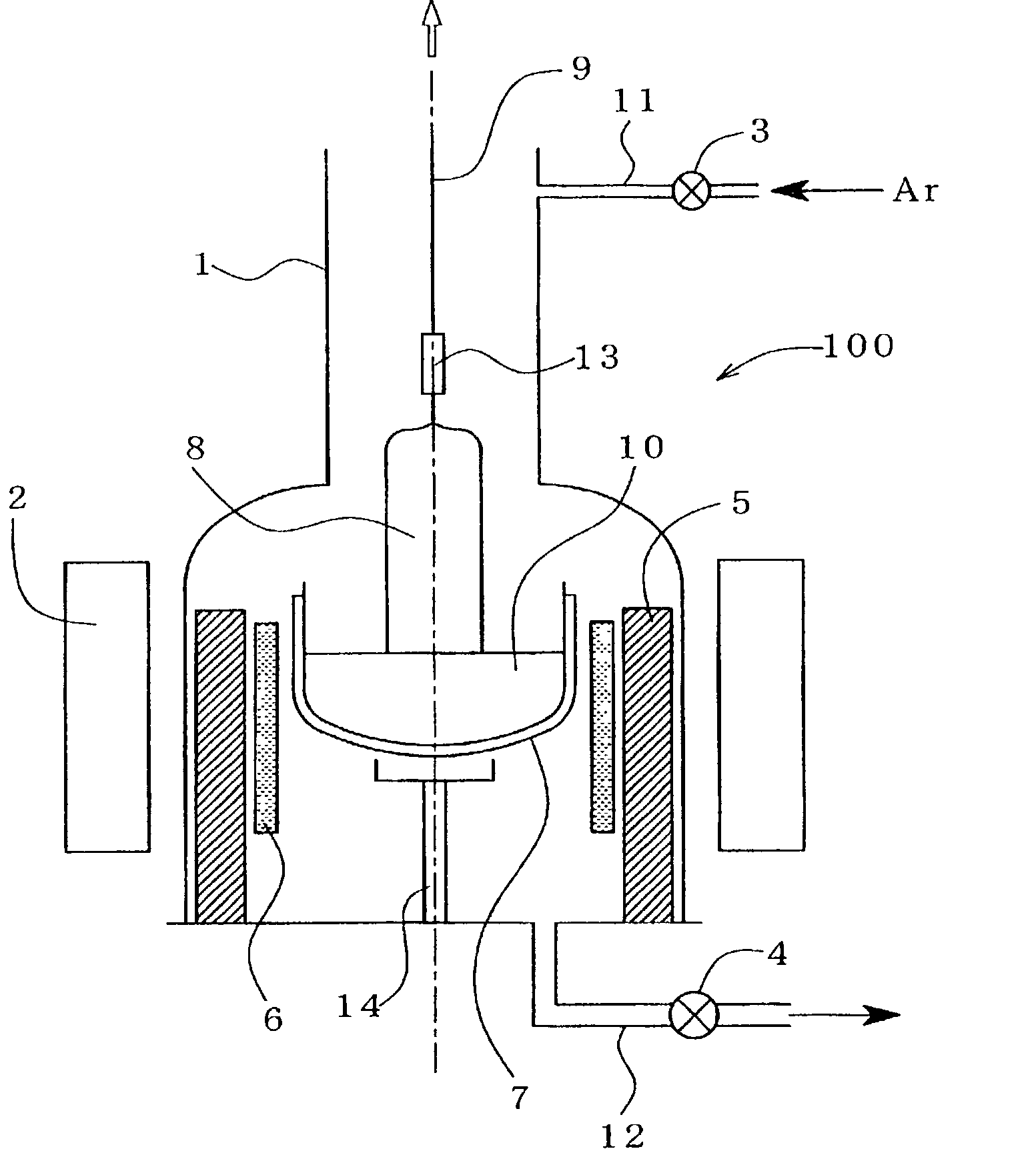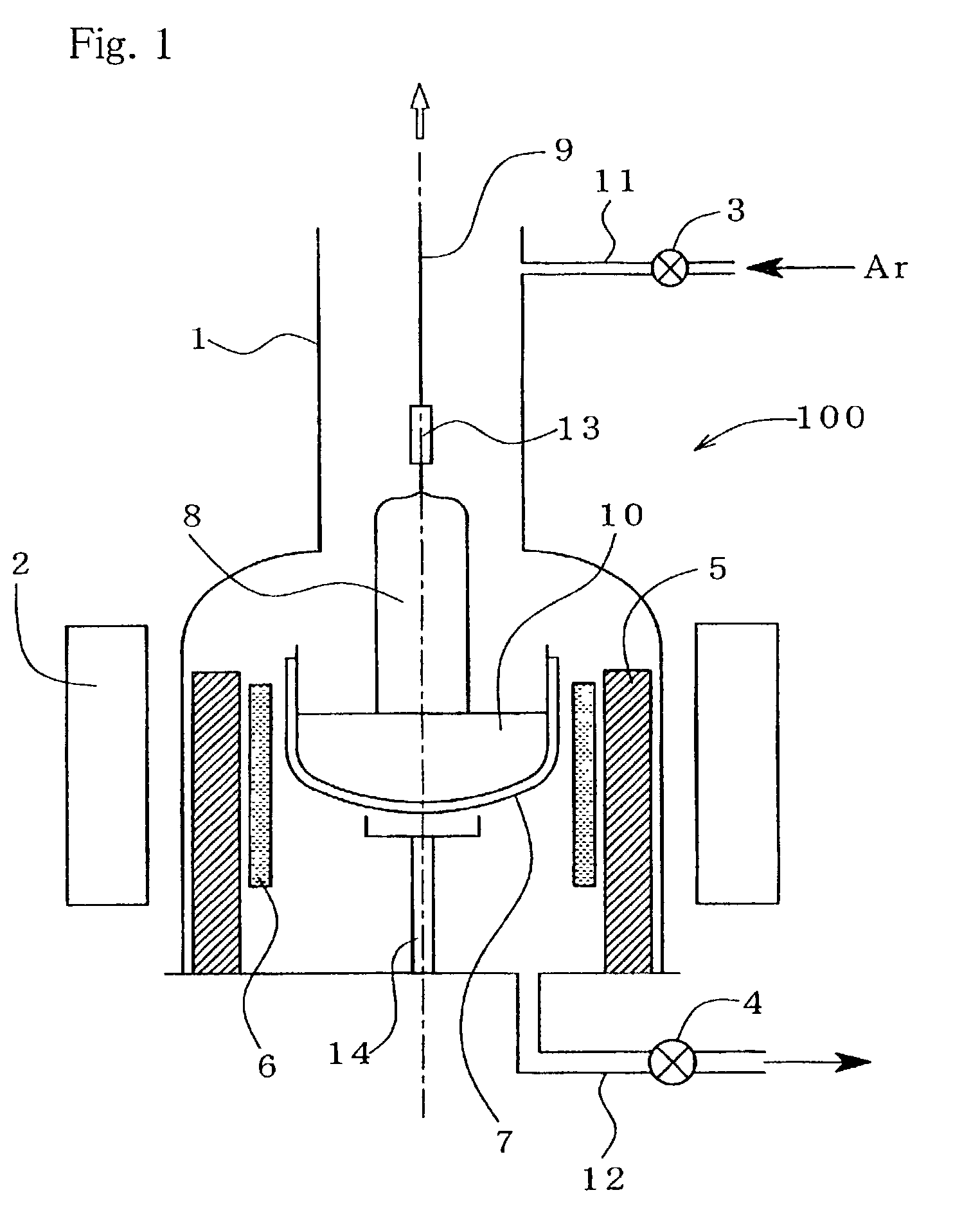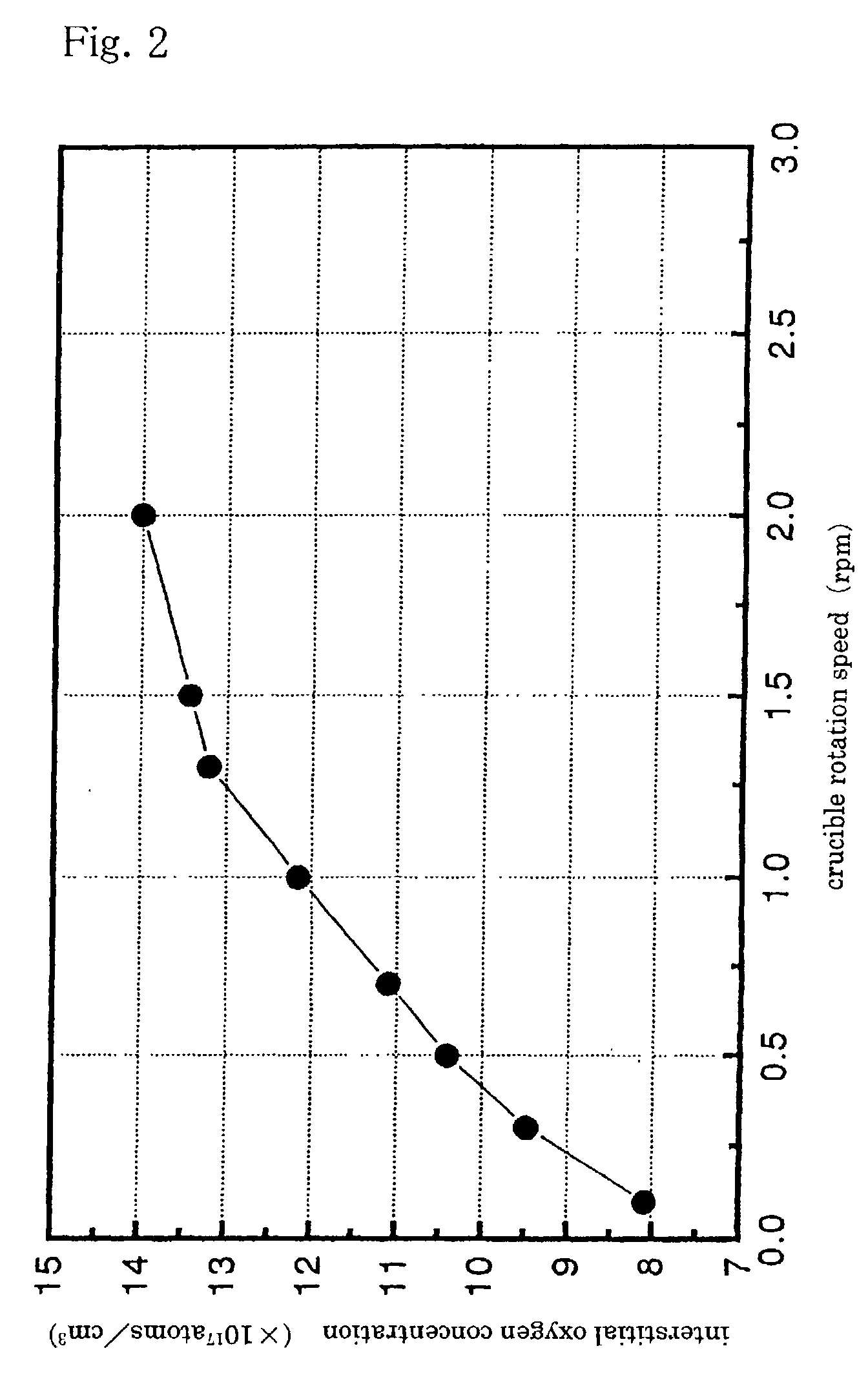Therefore, characteristically, not only does a silicon
wafer from such a single crystal come to have a large
resistance force against various thermal strains received when
semiconductor elements are fabricated thereon, but dislocations such as slippage are also difficult to be produced therein (see K. Sumino:
Semiconductor Silicon 1981, Electrochem. Soc., Penington 1981 p.
However, on the other hand, as interstitial oxygen existing in a
wafer increases, a forming amount of BMDs also increase and with the forming amount in excess, especially, in a wafer
surface layer which is an element forming region, the BMDs are a cause for a leakage failure at element junction interfaces, which in turn invites deterioration in element characteristics, resulting in loss of an essential function of a
semiconductor integrated circuit by chance.
Therefore, it is very important when semiconductor elements are fabricated in the
surface layer of a wafer to keep an interstitial oxygen concentration in a CZ method silicon single crystal at a proper value, which produces a problem of how to control an interstitial oxygen concentration in a crystal at proper value in order to take care of a
high density and high degree of integration of a
semiconductor device, such that the control of an interstitial oxygen concentration have further become an important factor in maintaining a product quality of an
integrated circuit.
As a result, oxygen dissolved from the
crucible wall also decreases, in turn an oxygen concentration in the latter half of a grown crystal decreases to a value equal to or less than a desired value, and thereby, there arises a chance to be unable to ensure a necessary quality.
In this method, however, it has been said to be hard to achieve a high precision control of an interstitial oxygen concentration adapting to growth of a single crystal since, in a
quartz crucible of as large a size as a
diameter in excess of 200 mm, there exists a distance between a crucible wall supplying oxygen and a
crystal growth interface, which in turn causes a
delay in time for a melt to reach the
crystal growth interface.
As a result, in a case where a
large size crystal equal to or more than, especially, 200 mm in
diameter is pulled, there has been an inevitable limitation on control to suppress variations in interstitial oxygen concentration due to the above inconvenience.
In one aspect of this method, however, somewhat troublesome faults have been encountered in setting of and adjustment for growing conditions of a single crystal since an oxygen concentration is excessively low by chance depending on growth conditions for a single crystal when a BMD density is desired at a necessary and sufficient level in a wafer, therefore, a special technique is required to be performed for achieving a
high oxygen concentration on a specific target quality of a crystal and a growth state of the crystal.
In the MCZ method, however, by growing a silicon single crystal under application of a
magnetic field to a silicon melt, a turbulent in the melt produced by thermal
convection in the melt and rotation of a crucible can be efficiently suppressed, so an amount of oxygen supplied to a region in the vicinity of a
crystal growth interface is caused low, with the result that a single crystal of a
low oxygen concentration can be grown.
According to a prior art MCZ method, however, in use of a
large size quarts crucible for growth of a single crystal as large a
diameter as to exceed 200 mm, as described above,
convection in a silicon melt is extremely suppressed by a
magnetic field and thereby, more of a
delay in time arises for a melt portion on a crucible wall surface to reach a growth interface, which in turn results in more of difficulty in terms of high precision control of an interstitial oxygen concentration adapting to growth of a crystal.
Note that, in a MCZ method, although a proposal is made on a method adjusting an oxygen amount supplied into a silicon melt from a crucible wall in which as an pulling amount of a single crystal
ingot increases, a
magnetic field applied to the silicon melt is reduced in strength, this has not been able to be a decisive solution as great as to be dramatic improvement of suppression of variations in interstitial oxygen concentration in pulling a single crystal of equal to or more than 200 mm in diameter either.
Especially, in a large diameter single crystal of 200 mm or more (for example, 8 inches), 250 mm or more (for example, 10 inches) or 300 mm or more (for example, 12 inches), it was traditionally very difficult to
restrict variations in interstitial oxygen concentration to a sufficiently low level even by adopting an MCZ method.
With no relation to an amount of a melt in a crucible, an effect of removing an
oxide evaporating from the surface of the melt becomes low with a flow rate of the
inert gas flowing in the furnace equal to or less than 40 l / min and thereby, a case arise by chance where it is hard to properly control an oxygen concentration in the melt.
Furthermore, an effect of removing an
oxide evaporating off away from the melt becomes low: therefore, not only does the upper end of a quarts crucible and an oxide attach onto portions which have low temperature in the growth furnace to contaminate the inner structure of the growth furnace, but also the attachment has a chance to fall onto the surface of the melt to disturb cystallization of silicon.
On the other hand, the
inert gas flow rate more than necessary is also problematic.
When an amount of the
inert gas is in excess, an amount of oxygen to be removed from the melt surface increases and an amount of oxygen supplied from the crucible increases in a corresponding manner, whereby deterioration of a
quartz crucible is accelerated, resulting in difficulty in operation for a long time.
Furthermore, when an amount of the
inert gas flowing over the melt surface increases, ripples arise on the melt surface, by which there arises a fear that the ripples produce an inconvenience such as to create dislocations in a single crystal in growth and further, which brings a
disadvantage in an aspect of manufacture cost because of increase in consumption of the inert gas.
Under a pressure in the growth furnace of 40 mbar or less, an amount of an oxide such as SiO evaporating off away from the surface of a melt increases to a level in excess of a necessary value and an amount of supply of oxygen from a
quartz crucible wall increases to thereby deteriorate a durability of the crucible; therefore, there arise a case where
single crystal growth over a long time becomes difficult.
On the other hand, in a case where operation is performed under a condition in excess of 300 mbar, while an amount of oxide evaporating from the melt can be suppressed, a pressure in the growth furnace becomes excessively high, whereby SiO attaches on a furnace wall, a
hot zone (a structure in the furnace) and others to disable
visual observation in the furnace or crystal growth suffers falling-off of the attached SiO onto the melt resulting in disturbance of growth of a crystal by chance, which is not preferable from the viewpoint of actual operation.
Especially, since the center of the magnetic field is located on a crystal growth axis in the melt, a suppressing effect on
convection in the vicinity of a crystal growth interface is large and it takes a time from when a rotation speed of a crucible is altered till an influence of the change in rotation speed is exerted on an oxygen concentration in the melt in the vicinity of a crystal growth interface, having resulted in a problem in regard to precise control of an amount of oxygen incorporated into a crystal.
 Login to View More
Login to View More  Login to View More
Login to View More 


